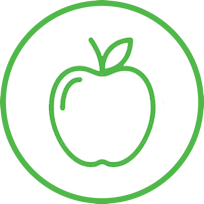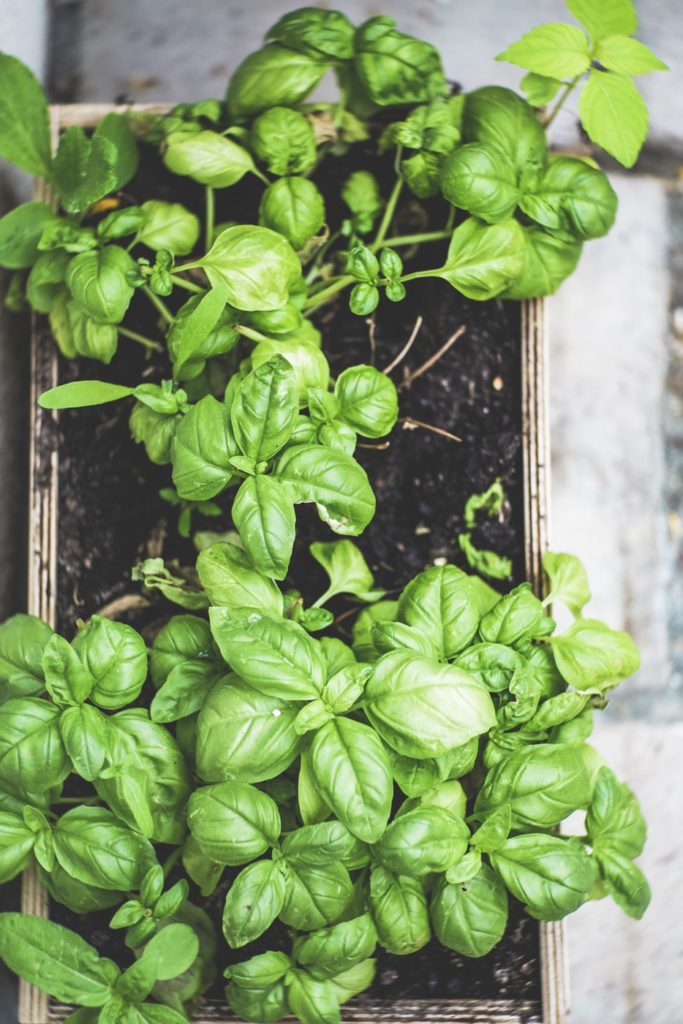*This blog was co-written with Caroline Chomanics, IDEAS For Us chief administration officer and Fleet Farming program manager.
We are beginning a new decade in 2020! Unlike most New Year’s resolutions, these don’t require you to break a sweat at the gym or reorganize your closets, Marie Kondo style. As 2019 comes to an end, it’s time to start thinking about the environment and sustainability. While chucking your plastic water bottles into a recycling bin helps, there’s more you can do to take part in the green movement. Here is a list of 20 ways to be more sustainable in 2020.

Energy

1. Change all of your light bulbs to LED
Take a moment today to make sure your home is using all LED light bulbs. LEDs typically use about 75% less energy than traditional incandescents and can last at least 35 times longer. This may seem incidental in helping people transition to clean energy. But at least it’s a solution that’s bright! 💡
2. Plug large electronics into a smart power strip
Did you know you have an unseen menace lurking in your home, stealing electricity and spiking your power bills? “Phantom loads,” or energy vampires, as they’re appropriately called, refer to the electricity an appliance or a device consumes even when it’s not in use. Leaving unused devices plugged into outlets can cost you, on average, up to $200 more per month in electricity. Smart power strips shut off the power to your electronics when you’re not using them, saving you the hassle of having to remember to unplug your devices each time. This is a smart way of using less energy at home, while also saving money. 😎
3. Get an energy audit
This is an audit you’ll look forward to–and it will save you money in the long run! Energy audits tell you how much energy your home or business is losing and provide cost-efficient, sustainable solutions. Other benefits include reducing environmental damage and pollution, lowering energy bills and extending the lifespan of your current energy systems. For a local resource, try Absolute Sustainability, an energy consulting agency that helps residences and businesses reduce unnecessary energy use while improving the quality of existing energy output.
4. Check all weatherproofing on windows
Energy can easily be lost with the gaps and spaces between doors and windows. This has a major environmental cost in 70% of greenhouse gases that can be attributed to the energy usage of buildings. Grab some caulking and weather stripping to help prevent energy loss of your home or business.

Water

5. Switch to reusable water bottles
Despite recent images of oceans brimming with plastics and marine life washed ashore, Americans still use an average of 50 billion plastic water bottles a year. And while recycling has become part of a modern lifestyle, an unsettling fact remains: 91% of plastic is not recycled. Switching to reusable water bottles such as a mason jar or an ethically made product is an easy way to eliminate your use of plastics. And like most sustainable options, it will save money.
6. Install a low-flow showerhead or a shower timer
It’s no surprise that showers can be a major source of in-home water consumption. According to the Alliance for Water Efficiency, “The average American shower … lasts for 8.2 minutes at an average flow rate of 2.1 gallons per minute.” You can help conserve water by taking shorter showers (five minutes, tops), using a timer to keep you on time. Another option: You can install a low-flow showerhead.
7. Install a toilet buddy
Many of us don’t want to think about all the times we flush in a day, all the water we’re wasting when there’s an increasingly dwindling supply. Sewage often gets short shrift in discussions about water conservation. And while flushing is, well, necessary, there are ways to eliminate water-wasting problems that could be coming from your toilet. For instance, your toilet could be outdated. Older toilets use up to three to seven gallons more per flush. Most toilets have a date stamped either inside or on the back wall of the tank. If your toilet is more than 20 years old, it’s time for a new one. But if this is an expensive option, toilet buddies can help with reducing high-flush volume. A DIY alternative is to pour water down the toilet to cut down on excessive flushing.

Food

8. Compost your food and yard waste
Composting at home is easy! All you need is a container for your freezer to place food scraps during the week and a composting area outside for excess food scraps when the bin fills up. Your composting area can be a hole where you regularly till the compost, a composter product or even a worm bin in your apartment.
9. Grow your own herbs
Growing your own food is one of the biggest ways to become more sustainable. Novices to the world of food-growing can begin with garden herbs. These lovely food accents not only add a welcome burst of flavor to any meal, but fill your home with an array of lush, earthy scents. The five easiest herbs to start with (depending on your climate) are basil, oregano, thyme, mint and parsley. These can be grown in pots with six hours of bright sunlight, and only need watered a few times a week. For more info on growing herbs in your home, check out this blog by Cooking Light.
10. Shop at your local farmers market
Farmers markets are popping up everywhere. And for good reason. They’re a great way to while away a sunny afternoon. Shopping local also supports community growers and small business economies. Locally, we recommend stopping by the Audubon Park Community Farmers Market for your weekly produce. While there, peruse the works of local artisans and other unique vendors. But make sure you bring a reusable bag!
11. Zero waste your food shopping
As the name implies, zero-waste sends nothing unnecessary or deemed recyclable, to landfills. A refrain of the zero-waste philosophy is reuse, reuse, reuse! Bulk stores or bulk sections are boons for those looking to shop zero waste. Bring your own bag or container to the grocery store, and before stocking up on dry goods, ask for the “tare,” to see how much your container weighs when empty. Also, opt for purchasing tin cans or paper-wrapped items rather than items with plastic packaging. According to the United Nations, “nearly 50% of the plastic waste generated globally in 2015 was from the packaging.” To learn more about shopping zero waste, see our blog.

Waste

12. Follow the protocols of proper recycling
Let’s make 2020 a year of proper recycling. A good rule of thumb is the following recycling guide:
- Plastic can usually be recycled in the mixed recyclables section if they are numbered 1 through 7 on the packaging.
- Cardboard and white paper can be recycled in the paper section
- Caps, paper with wax, plastic bags, plastic film, and Styrofoam should not be placed in recycling bins.
- Food must be washed off items before being recycled.
Most cities will also have the details of how to recycle within their area. For instance, here’s the link for the city of Orlando’s recycling standards: https://www.orlando.gov/Trash-Recycling/What-Goes-Where.
13. Deny all plastic bags!
Plastic is old news! Stock up on reusable bags and conveniently place them in your car, in your purse, at work, and at home. You’ll never have an excuse to use another plastic bag in 2020. Have you ever heard someone say, “Well, I use them for dog poop bags”? Yes, we even recommend using biodegradable to-go poop bags, like these.
14. Shop at thrift stores
News flash: Shopping secondhand is cool! Rather than contribute to waste production by shopping new, go to your local thrift store for clothing, furniture, decor and housewares. This is an excellent way of reusing items in your own community and switching to a more sustainable lifestyle.
15. Purchase sustainable toothbrushes and reusable ear swabs
Plastic toothbrushes take over 400 years to decompose. That’s why bamboo toothbrushes are the perfect alternative: They are 100% biodegradable and antimicrobial–which means they don’t harbor nasty bacteria. You can purchase them in compostable packaging and buy in bulk for the whole year. If you think using an electric toothbrush gets you off the hook, you’re wrong. Electric toothbrushes use electricity and require batteries that, when dumped in landfills, leak battery acid into waterways and oceans.
Maybe some of you know that every year millions of swabs end up in the ocean, which is disastrous for our planet’s future. If you are concerned about our planet, then it’s the right time to throw away all your single-use items and get your reusable alternatives like LastObject’s reusable swabs. You can use these eco-friendly swabs over 1000 times and after every usage, you can wash them with soap and water.
16. Switch from paper towels to reusable rags
One of the easiest ways to be more sustainable in 2020 is to replace paper towels with recycled cloths. Just as plastic chokes waterways, unrecyclable paper produces unnecessary waste in landfills. In a pinch, it’s easy to grab a paper towel to clean up a spill. But think about the number of paper towels discarded each year, with every household on the planet. According to the Paperless Project, it’s 254 million tons. Besides, reusable cloths can do the job faster, by soaking up more liquid with less material and waste. Check out this plant-based company for sustainable cleaning tools.
17. Purchase recycled toilet paper
Here’s an astounding fact: We flush the equivalent of 270,000 trees down the drain each day, and nearly 10% of that is attributable to toilet paper. Recycled toilet paper can be a sustainable game-changer. Check out this company called Who Gives a Crap, which offers recycled toilet paper and “forest-friendly” tissues and paper towels.

Ecology

18. Put up a native birdseed bird feeder
Bringing nature closer to work or home is easy with a bird feeder. Make sure to purchase only native birdseed (with no sugared or dried fruit) for a way to support the beautiful birds in your neighborhood.
19. Install a solitary beehive
Bees need our help! Solitary beehives are man-made “insect hotels” that act as a place for pollinating species to take residence. They can add habitat to your yard, in an easy and beautiful way.
20. Plant native plants
When deciding what you can do to save the ecosystems in your area, the answer is simple: Grow native plants! Supporting local wildlife is the key to regenerating our ecosystems. Look into the native wildflowers, trees, shrubs, and vines suitable to your environment, to create habitat in your own home or office. Live in Florida? Here is a helpful resource for finding native plants, as well as another for finding both native and non-native shrubs and bushes that grow well in Florida.
Sources:
https://www.energy.gov/eere/articles/warding-energy-vampires-and-phantom-loads
https://www.energysage.com/energy-efficiency/101/ways-to-save-energy/
https://www.worldgbc.org/sites/default/files/UNEP%20188_GABC_en%20%28web%29.pdf
https://www.oakcreekplumbing.com/is-your-toilet-wasting-water
https://www.cookinglight.com/healthy-living/green-living/how-to-start-your-own-herb-garden
https://www.orlando.gov/Trash-Recycling/What-Goes-Where
https://blog.nationalgeographic.org/2010/04/16/toilet-paper-wipes-out-27000-trees-a-day/








